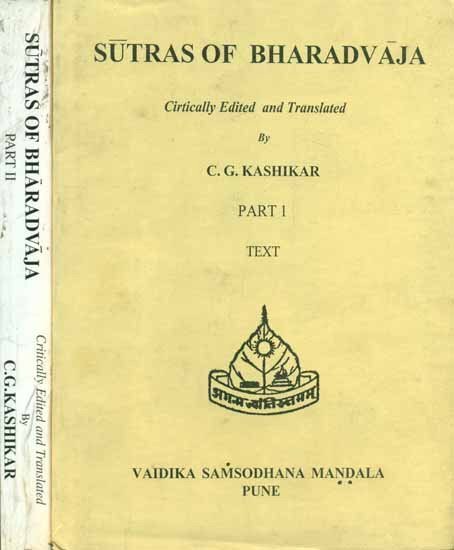Bharadvaja-srauta-sutra
by C. G. Kashikar | 1964 | 166,530 words
The English translation of the Bharadvaja-Srauta-Sutra, representing some of the oldest texts on Hindu rituals and rites of passages, dating to at least the 1st millennium BCE. The term Srautasutra refers to a class of Sanskrit Sutra literature dealing with ceremonies based on the Brahmana divisions of the Veda (Sruti). They include Vedic rituals r...
Praśna 8, Kaṇḍikā 3
1. The sacrificer should follow the offering to Pūṣan with the formula, “May I become bountiful and rich in cattle through the sacrifice to Pūṣan.”
2. With this very formula, he should follow all the offerings to Pūṣan.
3. After having offered the āmikṣā, the Adhvaryu should place the cake on one potsherd on the Barhis, spread clarified butter as base into the Juhū, and take up the whole cake on one potsherd.
4. At this stage he should sprinkle'around that cake the clarified butter which formerly lay around it, pour out clarified butter upon it, and offer it by means of the ladle in such a way that it would remain steady on the fire.
5. If the cake, after it is offered, turns upside-down, he should take it back, pour clarified butter upon it, and offer it again.
6. According to some teachers, the sacrificer should give a boon to the Adhvaryu, who should then set it right by means of the ladle, not by means of his hand.
7. The Adhvaryu should then offer an oblation on it with the formula representing four of the Month-names, namely, “To Madhu svāhā,” “To Mādhava svāhā,” “To Śukra svāhā”, “To Śuci svāhā.”[1]
8. The sacrificer should murmur the formula, “I invoke the grace lasting for one year,” in connection with the benedictions pertaining to the Iḍā.
9. The dakṣiṇā is the calf first born in the season.[2]
10. The Adhvaryu should offer nine Anūyājas with the pṛṣadājya.
11. The Hotṛ should modify the Sūktavāka as, “He invokes the grace lasting for one year, he invokes celestial brilliance.”[3]
12. Having thrown the enclosing sticks on the Āhavanīya fire, he should say (to the Hotṛ), “Do you recite the puronuvākyā in connection with (the offering for) the Vājins.”
13. Having spread out clarified butter as base into the Juhū or into the goblet, he should take the vājina into it while dropping it oṇ the Barhis.
14. Without pouring out clarified butter on the oblation, he should cross the altar (towards the south), cause the Āgnīdhra to announce, and (after the latter has responded,) say (to the Hotṛ), “Do you recite the yājyā in connection with (the offering for) the Vājins.”
15. At the vaṣaṭ-utterance, he should offer the vājina through the ladle while it is dropping down.
16. At the subsequent vaṣaṭ-utterance, he should offer it for the second time.
Footnotes and references:
[1]:
cf. Taittirīya-saṃhitā IV.4.11.1.
[2]:
Or a couple of cow and bull, according to Āpastamba-śrauta-sūtra VIII.249.
